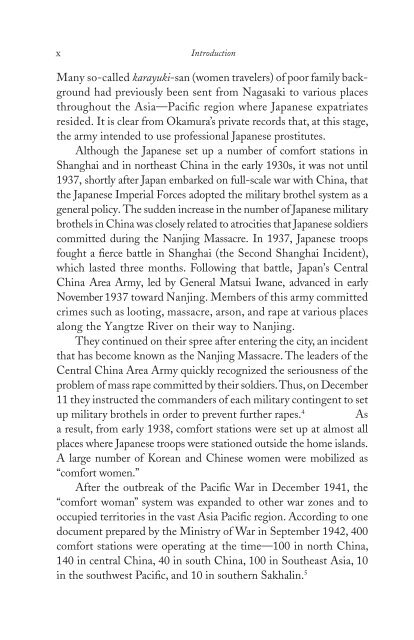Comfort Woman : a Filipina's Story of Prostitution and Slavery Under ...
Comfort Woman : a Filipina's Story of Prostitution and Slavery Under ...
Comfort Woman : a Filipina's Story of Prostitution and Slavery Under ...
Create successful ePaper yourself
Turn your PDF publications into a flip-book with our unique Google optimized e-Paper software.
x<br />
Introduction<br />
Many so-called karayuki-san (women travelers) <strong>of</strong> poor family background<br />
had previously been sent from Nagasaki to various places<br />
throughout the Asia—Pacifi c region where Japanese expatriates<br />
resided. It is clear from Okamura’s private records that, at this stage,<br />
the army intended to use pr<strong>of</strong>essional Japanese prostitutes.<br />
Although the Japanese set up a number <strong>of</strong> comfort stations in<br />
Shanghai <strong>and</strong> in northeast China in the early 1930s, it was not until<br />
1937, shortly after Japan embarked on full-scale war with China, that<br />
the Japanese Imperial Forces adopted the military brothel system as a<br />
general policy. The sudden increase in the number <strong>of</strong> Japanese military<br />
brothels in China was closely related to atrocities that Japanese soldiers<br />
committed during the Nanjing Massacre. In 1937, Japanese troops<br />
fought a fi erce battle in Shanghai (the Second Shanghai Incident),<br />
which lasted three months. Following that battle, Japan’s Central<br />
China Area Army, led by General Matsui Iwane, advanced in early<br />
November 1937 toward Nanjing. Members <strong>of</strong> this army committed<br />
crimes such as looting, massacre, arson, <strong>and</strong> rape at various places<br />
along the Yangtze River on their way to Nanjing.<br />
They continued on their spree after entering the city, an incident<br />
that has become known as the Nanjing Massacre. The leaders <strong>of</strong> the<br />
Central China Area Army quickly recognized the seriousness <strong>of</strong> the<br />
problem <strong>of</strong> mass rape committed by their soldiers. Thus, on December<br />
11 they instructed the comm<strong>and</strong>ers <strong>of</strong> each military contingent to set<br />
up military brothels in order to prevent further rapes. 4 As<br />
a result, from early 1938, comfort stations were set up at almost all<br />
places where Japanese troops were stationed outside the home isl<strong>and</strong>s.<br />
A large number <strong>of</strong> Korean <strong>and</strong> Chinese women were mobilized as<br />
“comfort women.”<br />
After the outbreak <strong>of</strong> the Pacifi c War in December 1941, the<br />
“comfort woman” system was exp<strong>and</strong>ed to other war zones <strong>and</strong> to<br />
occupied territories in the vast Asia Pacifi c region. According to one<br />
document prepared by the Ministry <strong>of</strong> War in September 1942, 400<br />
comfort stations were operating at the time—100 in north China,<br />
140 in central China, 40 in south China, 100 in Southeast Asia, 10<br />
in the southwest Pacifi c, <strong>and</strong> 10 in southern Sakhalin. 5

















